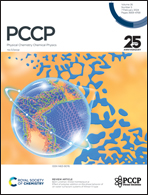Carrier doping modulates the magnetoelectronic and magnetic anisotropic properties of two-dimensional MSi2N4 (M = Cr, Mn, Fe, and Co) monolayers†
Abstract
Through extensive density functional theory (DFT) calculations, our investigation delves into the stability, electrical characteristics, and magnetic behavior of monolayers (MLs) of MSi2N4. Computational analyses indicate intrinsic antiferromagnetic (AFM) orders within the MSi2N4 MLs, as a result of direct exchange interactions among transition metal (M) atoms. We further find that CrSi2N4 and CoSi2N4 MLs with primitive cells (pcells) exhibit half-metallic properties, with respective spin-β electron gaps of 3.661 and 2.021 eV. In contrast, MnSi2N4 and FeSi2N4 MLs with pcells act as semiconductors, having energy gaps of 0.427 and 0.282 eV, respectively. When the SOC is considered, the CrSi2N4, MnSi2N4 and FeSi2N4 MLs are metals, while the CoSi2N4 ML is a semiconductor. Our findings imply the dynamics and thermodynamic stability of MSi2N4 MLs. We have also explored the influence of carrier doping on the electromagnetic attributes of MSi2N4 MLs. Interestingly, charge doping could transform CrSi2N4, MnSi2N4, and CoSi2N4 MLs from their original AFM state into a ferromagnetic (FM) order. Moreover, carrier doping transformed CrSi2N4 and CoSi2N4 MLs from spin-polarized metals to half-metals (HMs). It is of particular note that doping of CrSi2N4 MLs with +0.9 e per pcell or more holes caused a switch in the easy axis (EA) to the [001] axis. The demonstrated intrinsic AFM order, excellent thermodynamic and kinetic stability, adjustable magnetism, and half-metallicity of the MSi2N4 family suggest its promising potential for applications in the realm of spintronics.



 Please wait while we load your content...
Please wait while we load your content...